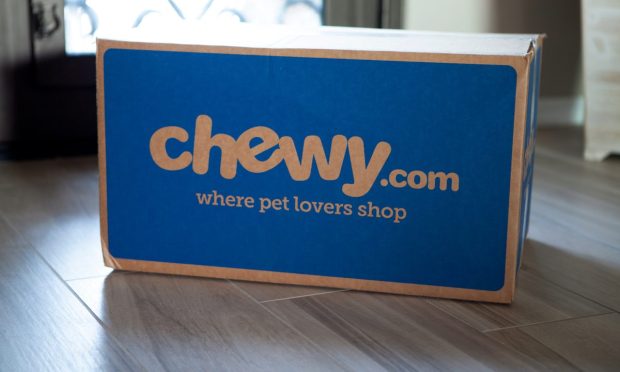Chewy Is Half of What It Used to Be as It Prepares to Report Q4 Results

Dog fighting may be outlawed everywhere, but dog food fighting is alive and well.
In fact, the economics within the massive pet care industry are robust and growing, and in many circles are seen as more defensive to inflation-driven belt tightening by consumers than those of the more human-oriented non-discretionary variety such as groceries.
That said, the digital darling of the pet care space finds itself in a bit of funk, as Miami-based Chewy is literally half the size it was 15 months ago, having fallen 50% from its Jan. 2021 peak of $120 per share.
While still packing a formidable $20 billion market cap punch, the online retailer has struggled to impress investors the way that it has its growing legion of customers, many of which have adopted subscription plans to nurture their pet-related needs.
“Demand and consumer engagement remained strong,” Chewy CEO Sumit Singh told investors three months ago of the 11-year-old company’s Q3 results, adding that the online retailer’s sustained growth reflected “the soundness of its strategy, the uniqueness of its value proposition, and the durability of the pet category.”
Even though Chewy delivered 24% sales growth last quarters, which marked an 86% jump on a two-year basis, investors yawned and took the stock down another 10% the next morning.
To be fair, Chewy has enjoyed a nice 20% bounce over the past week, but even so, its stock is still down 15% from where it was at the end of Q3.
Pet Peeves
Consumers clearly love their pets, as evidenced by the fact that over 10 million people adopted a “COVID cat or dog” during the lockdown phase of the pandemic, and PYMNTS “Dognomics” data reflects an industry that has grown into a $100 billion colossus filled with digital, physical and omnichannel players, both local and national in nature.
Although only a fraction of the size of Chewy, the $6 billion, 1,600-store, relaunched and rebranded “Petco Health + Wellness Company” is aggressively leveraging its physical footprint and growing fleet of in-store vet hospitals as a wedge.
“We enter this fiscal year as a stronger company than ever,” Petco Chair and CEO Ron Coughlin said three weeks ago, reflecting on the retailer’s Q4 and first set of full year results since its relisting as a public company for the third time last year in an event dubbed a “Tri-P-O.”
“Our category remains strong and resilient; our competitive moats are deepening,” Coughlin continued. “With an integrated omnichannel infrastructure, robust services offering including 197 veterinary hospitals, and millions of net new customers, we’re well positioned to drive enhanced long-term shareholder value,” he said, despite a 30% slump in the stock since Jan 2021.
Even so, Petco and now privately held PetSmart are both striving to be more like Chewy and working to grow their digital, subscription, curbside and medication businesses, within their existing footprints and websites.
The Non-Specialty Rivals
As pet stores broaden their existing portfolios, players like Petco move to find new ways to meet customers where they’re at. In January, for example, the company moved to capture the convenience trend in pet care via the launch of a pilot program that will put 15 mini store-in-store outlets inside of Lowe’s locations.
Add in the fact that there are also countless local Mom and Pop stores, scores of new D2C players, and dozens of national and regional chains that operate several thousand locations, and it’s clear that the one thing pet owners aren’t lacking for is choice.
Further stoking this battle are an array of super aggressive general retailers who are also vying for a bigger slice of an enormous category that is outpacing most other segments. Whether it’s Amazon, Walmart, Target or Tractor Supply, or every single supermarket in the country, pet care ubiquity is not only real, but will continue to fuel competition and demand innovation, and likely leave investors waiting to hear something new.
